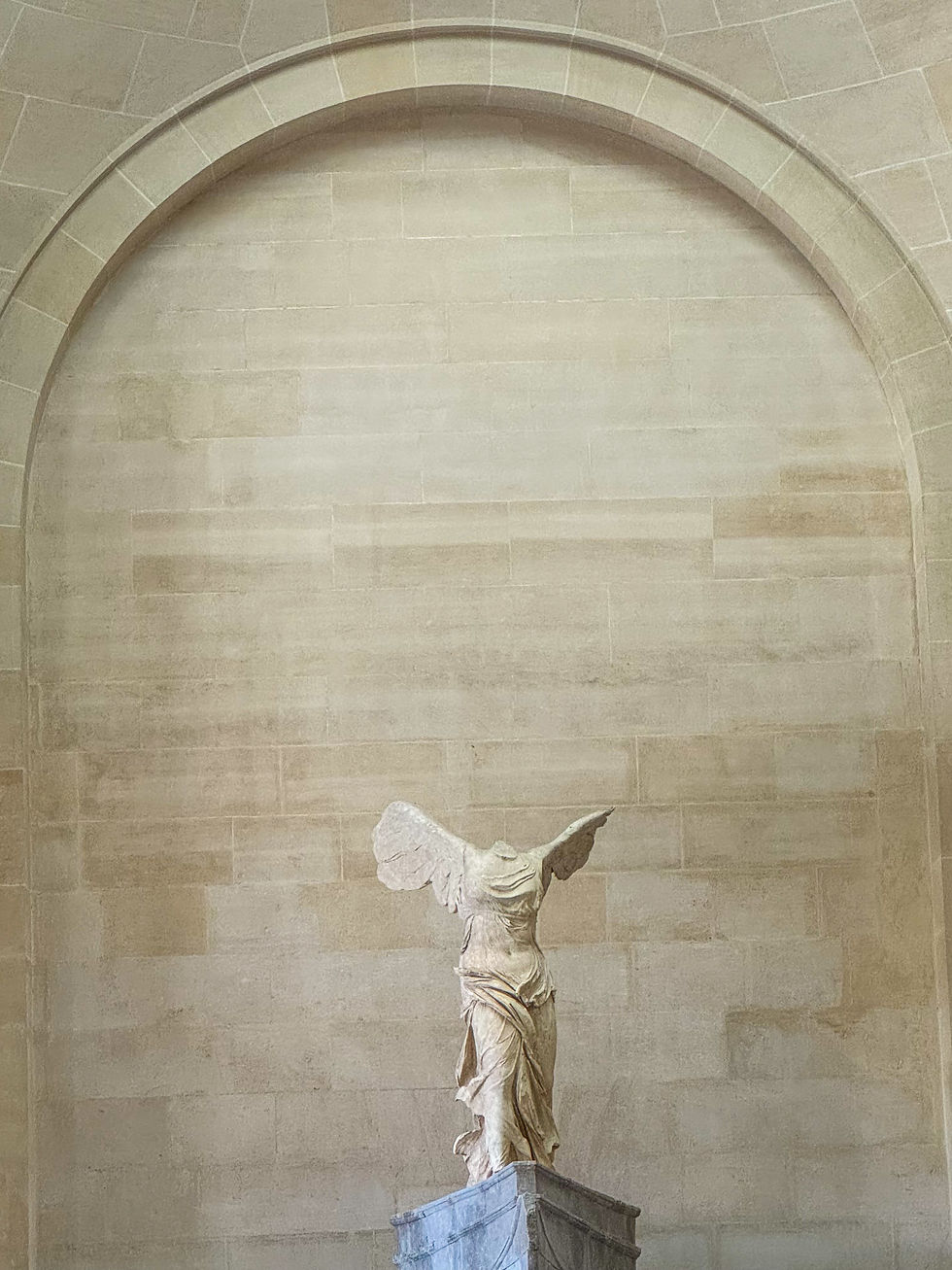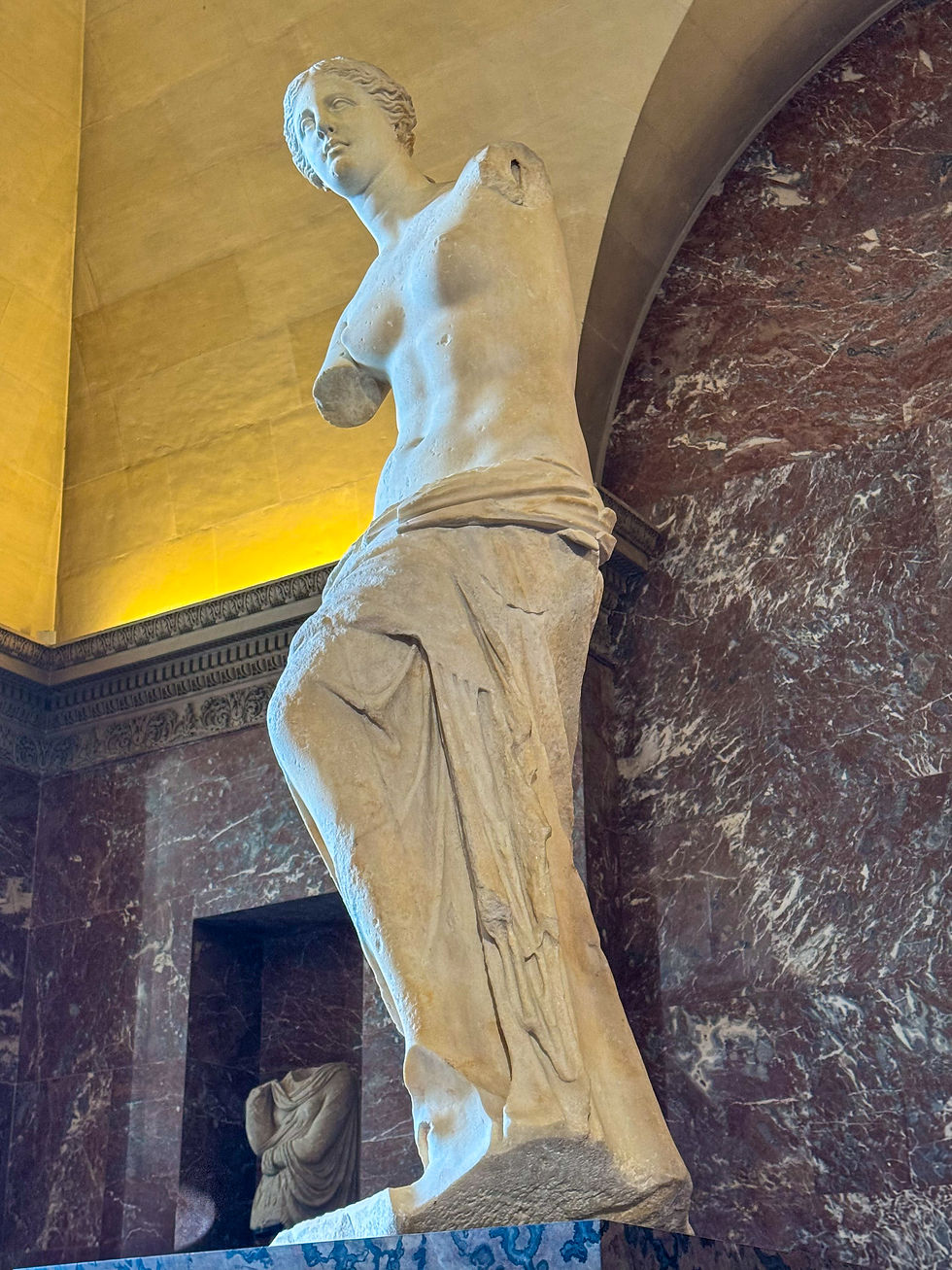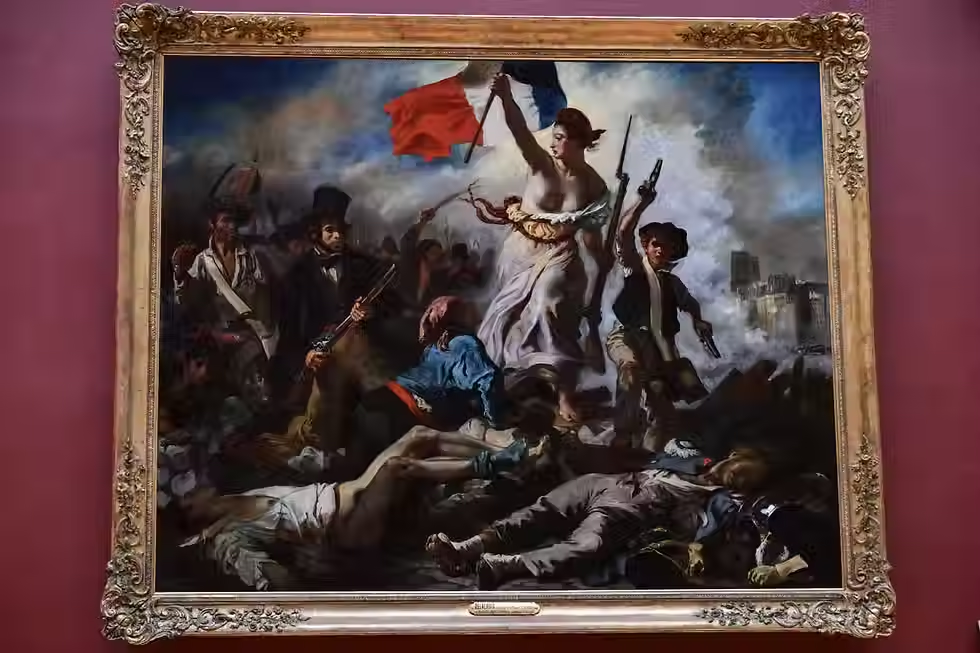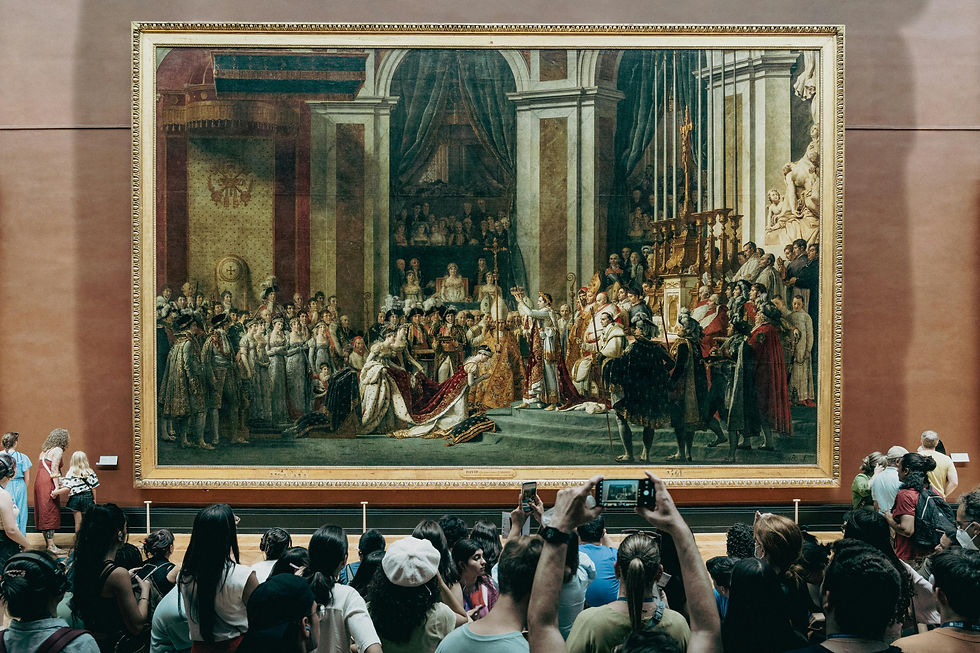Top 7 Must-See Pieces at the Louvre
- Joleen Raquel

- Jul 28
- 5 min read
Planning your visit to the Louvre? Here’s what you absolutely can’t miss.
During my recent trip to Europe, the one thing I knew I couldn't miss was the Louvre Museum in Paris.
The Louvre is massive. Like, you could spend an entire week there and still miss things kind of massive. With over 35,000 pieces on display, it’s easy to get overwhelmed. So if you only have a few hours—or just want to hit the highlights—this list is for you.
Here are the top 7 must-see pieces at the Louvre, including one hidden underground gem that most visitors don’t even know about: the original medieval castle walls.

1. The Mona Lisa (Denon Wing, Room 711)
Let’s get the obvious one out of the way. Yes, she’s small. Yes, there’s a crowd. But there’s something iconic about locking eyes with da Vinci’s most famous lady. Go early or late in the day to avoid peak crowds and enjoy her quiet smirk in peace.
The Mona Lisa isn’t just famous because of her smirk—though let’s be real, it is iconic. Painted by Leonardo da Vinci in the early 1500s, this portrait changed the game for how people approached art and emotion. It was one of the first to really show subtle, realistic human expression (thanks to da Vinci’s signature shading style, sfumato). And fun fact? Her fame skyrocketed after she was stolen from the Louvre in 1911 and missing for two whole years. Ever since, she’s been more than a painting—she’s a pop culture icon and a symbol of Renaissance innovation that still influences artists today.
Tip: The Mona Lisa is located in the Denon Wing, but don't rush off right after—you’ll find several other masterpieces nearby.

2. The Winged Victory of Samothrace (Denon Wing, Daru Staircase)
The Winged Victory of Samothrace is one of those pieces that completely takes your breath away. She’s bold, dramatic, and posted up at the top of the staircase like she knows she’s that statue. Made around 190 BCE to honor Nike, the goddess of victory, she was originally part of a monument celebrating a naval win—so the whole ship-like base? Totally intentional. She was found in pieces on the island of Samothrace in 1863, but even without a head or arms, she’s full of motion and power. The wind-blown look, the energy in her stance—it all still hits. Victory never looked so fierce.
As a lover of Greek/Roman mythology, this is the piece that gave me chills.
Why it’s a must-see: The placement, the lighting, the sheer energy of the sculpture—this one feels like a moment.

3. Venus de Milo (Sully Wing, Room 345)
The Venus de Milo is elegance carved in stone—and she knows it. Dating back to around 100 BCE, this statue is believed to represent Aphrodite, the Greek goddess of love and beauty. She was discovered on the island of Milos in 1820 (hence the name), and even though her arms are long gone, she still steals the spotlight. There’s something about her calm expression, soft curves, and confident posture that draws people in. She doesn’t need to do much—she just is. Timeless, mysterious, and effortlessly iconic, the Venus de Milo proves beauty really is in the details.

4. Liberty Leading the People by Eugène Delacroix (Denon Wing, Room 700)
The Liberty Leading the People painting by Eugène Delacroix is a total showstopper—like cinematic art brought to life. Painted in 1830 to commemorate the July Revolution that toppled King Charles X, it mixes raw emotion with striking symbolism. Liberty herself—a bare‑chested, Phrygian‑capped woman—leads a wildly diverse crowd across barricades, flag raised high, past fallen comrades. She’s part allegorical goddess, part gritty street fighter, and her energy practically leaps off the canvas. After nearly two centuries of yellowed varnish, the Louvre's recent restoration revealed Delacroix’s original colors again—blues, whites, reds rekindled with fresh intensity. Now back in all her glory, she’s more vivid than ever—a powerful symbol of revolution, democracy, and artistic freedom that still resonates around the world.

5. The Coronation of Napoleon by Jacques-Louis David (Denon Wing, Room 702)
The Coronation of Napoleon by Jacques-Louis David is what you get when art and drama go full spectacle. Painted between 1805 and 1807, this massive masterpiece—seriously, it’s over 20 feet wide—captures Napoleon crowning himself Emperor inside Notre-Dame Cathedral, with Pope Pius VII just sitting there awkwardly watching. David didn’t just paint what happened—he curated the scene to showcase power, control, and legacy, all wrapped in opulence. Every figure is detailed, every stare deliberate, and the whole vibe is peak imperial propaganda. It’s bold, theatrical, and a masterclass in visual storytelling, making it one of the Louvre’s most unforgettable historical flexes.

6. The Louvre Castle Foundations (Sully Wing, Medieval Louvre)
The Louvre Castle Foundations are one of the coolest hidden gems in the entire museum—and honestly, most people miss them. Tucked away in the Sully Wing, these medieval stone walls are the original remains of the fortress that stood here in the 12th century, way before it became an art museum. Walking alongside the old moat and crumbling castle base feels like stepping into a secret part of Parisian history. It’s dark, quiet, and wildly atmospheric—a total shift from the grand halls above. If you’re into hidden corners and ancient vibes, this spot is a must-see.

7. The Galerie d’Apollon (Denon Wing, Room 705)
The Galerie d’Apollon is pure drama—in the best way. Dripping in gold with a ceiling that looks straight out of a royal daydream, this gallery is where art meets jaw-dropping interior design. Originally designed for Louis XIV (yep, the Sun King himself), the room is a celebration of Apollo, god of the arts and light. It’s got everything: shimmering chandeliers, ornate moldings, and that over-the-top French grandeur you secretly live for. Oh, and it once housed the French crown jewels, so the sparkle is very much intentional. Even if you breeze past the paintings, the ceiling alone is worth the stop.
Pro tip: It’s one of the most photogenic rooms in the Louvre—don’t skip it!
Final Tips for Visiting the Louvre:
Download the official Louvre app or pick up a map—it’s easy to get turned around.
Wear comfy shoes. You’ll walk a lot.
Start early or late. The museum is busiest midday.
Don’t try to see everything. Pick a few key pieces and leave time to wander.
Whether you're a first-timer or coming back for a second round, the Louvre never disappoints. With a mix of world-famous works and lesser-known treasures (hello, medieval castle walls!), it’s a museum experience unlike any other.
Have you been to the Louvre? What piece surprised you the most? 🎨🏛️













Comments